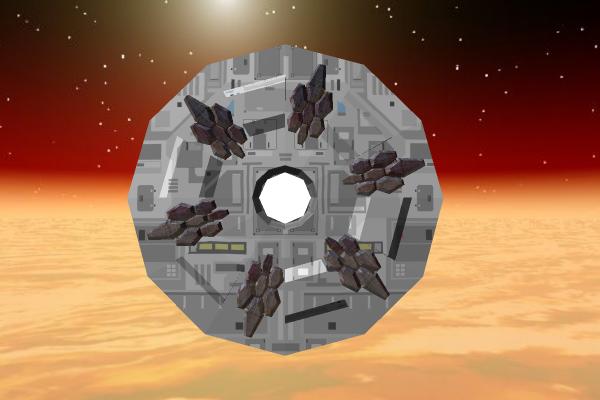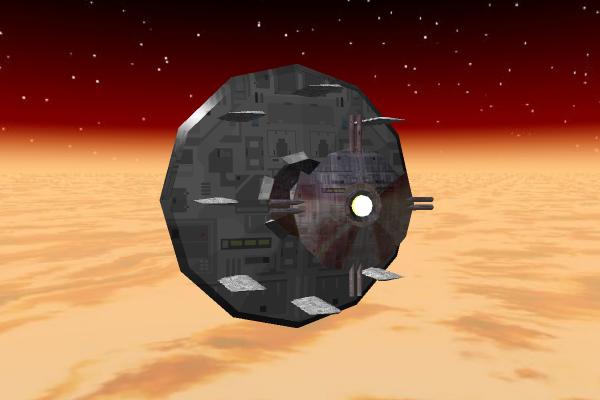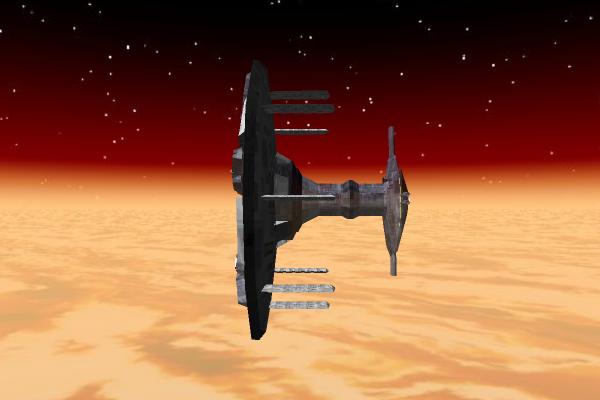Table of Contents
Antimatter Production Satellite
A specialized satellite placed into orbit around stars or black holes to produce a steady supply of antimatter.
About the Ship
With the need to build up the Imperial Weltraumflotte, the Abwehran Star Empire has expressed a desire to increase its production of antimatter for its weaponry and future projects. Because of this, the Antimatter Production Satellite was designed. A large automated satellite designed to be placed into orbit around an active star or a black hole, the Antimatter Production Satellite can use either Solar or Hawking Radiation to power is massive antimatter production equipment to produce antimatter much more cheaply than standard methods.
The proper distance for the Antimatter Production Satellite is 0.3 AU, but the actual orbit radius can vary between owners. The APS cannot get any closer to a star than 25 Solar Diameters (0.23 AU) or heat management systems will be overwhelmed.
Note: Antimatter Production Varies by distance between Collector and Star.
Key Features
The Antimatter Production Satellite is the first fully automated facility of the Abwehran Star Empire. Run by a Program AIM, it uses a specialized collector to power its antimatter production.
Mission Specialization
- To Produce Antimatter Cheaply and Efficiently.
Appearance
The Antimatter Production Satellite looks a lot like a lopsided dumbbell. With the largest disc holding the radiation collectors necessary to power antimatter production, the smallest disc holds the computer systems, storage facilities, and docking equipment. The cylinder connecting the two holds the antimatter production facility.
 View of Solar/Hawking Radiation Collector
View of Solar/Hawking Radiation Collector
 View of Docking Station
View of Docking Station
History and Background
With the call for military build-up in YE 28, Kaiserlich F&E created a separate team to work around the clock on producing a method of creating a steady supply of antimatter. While normal methods were enough for producing the small quantities of Antimatter Warheadss the Weltraumflotte needed, it wouldn't be enough for the scale of production required for the future. The simplest idea was the create a satellite in orbit around a star or black hole and use the radiation generated from either to produce the necessary power for production. Unfortunately, that would require a crew to serve on board a station with hardly any vacation time.
The solution to this problem came in YE 30 with the development of the CU-24 and Kesslinger Intelligent Operating System. With these two developments, designs for a fully automated production satellite was completed in YE 31 for mass-production.
Statistics and Performance
General
Class: Ay-P4-1a Type: Automated Satellite Designers: Kaiserlich F&E Manufacturer: Abwehran Imperial Yards Production: Mass-Production Fielded by:
- Other Corporations/Nations for the price tag of 6,000,000 AC 1)
Passengers
Crew: None. Maximum Capacity: About 5000 people can fit aboard in an emergency, but the station would be extremely cramped.
Dimensions
Collector Disc
- Diameter: 40 kilometers (24.85 miles)
- Thickness: 2.35 kilometers (1.46 miles)
Connector
- Diameter: 4.7 kilometers (2.92 miles)
- Length: 16.47 kilometers (10.23 miles)
Docking Disc
- Diameter: 11.76 kilometers (7.31 miles) 2)
- Thickness: 2.35 kilometers (1.46 miles)
Radiator Fins
- Length: 9.75 kilometers (6.06 miles)
- Width: 4.7 kilometers (2.92 miles)
- Height: 2.2 kilometers (1.37 miles)
Docking Arms
- Diameter: 1.11 kilometers (3641.73 feet)
- Length: 5.5 kilometers (3.42 miles)
Propulsion and Range
Range: In-System Lifespan: Ten Years Refit Cycle: Every Year.
Damage Capacity
See Damage Rating (Version 3) for an explanation of the damage system.
- Hull: 18 Ship SP
Inside the Ship
Compartment Layouts
Antimatter Factory
Located in the Connector section of the Satellite, the Antimatter Factory consists of 150 donut-shaped particle accelerators connected to two large chambers containing same particles collected from the Collector Disc. Each chamber launches multiple protons into the donut, which accelerates them fast enough to create antimatter when they collide. Anti-Particles are then sifted from the donut via a computerized identification process and sends the Anti-Particles to magnetic containment chambers in the Docking Disc. Each pair of particle accelerators are dedicated to a certain anti-particle: 50 for Positrons, 50 for Anti-Protons, and 50 for Anti-Neutrons.
The times below are averages when the satellite has been operational for a full day at a Orbital Radius of 0.30 AU.
| Antimatter Production Times | |
|---|---|
| Particle | Production |
| Positrons | 640 grams/hour |
| Anti-Protons | 320 grams/hour |
| Anti-Neutrons | 530 grams/hour |
Antimatter Storage Tanks
Three Large storage tanks located in the Docking Disc each hold a particular particle: one for Positrons, one for Anti-Protons, and one for Anti-Neutrons. Each Storage tank is magnetically contained so keep anti-particles from contacting their counterpart particles and holds 400 cubic meters of Anti-Particles. Though it is never filled up entirely since it is emptied at least once a week.
Computer Control Room
At the size of a walk-in closet, the Computer Control Room holds the CU-24 Computer in charge of the facility. The satellite's computer is run by a Program AIM of the KIOS.
Docking Arms
Four pairs of long docking arms extend from Docking Ring at 90-degree intervals. Extending to a length of nearly five kilometers, the Docking Arms each contain one Zero-G Maintenance Tube to allow work crews onto the satellite and a series of magnetic containment tubes to pump antimatter into specialized tanks on docking vessels. This allows each anti-particle the ability to be transferred onto a transport so they can be sent to manufacturing facilities and containment sites.
Engineering
Radiator Fins
Eight Large surfaces attached to the Radiation/Particle Collector (side away from star/black hole) with a series of specialized tubes that run from the fins and throughout the Collector Disc and Connector. Liquid Nitrogen is pumped through the tubes to draw waste heat away from critical systems and towards the radiator fins where it is then radiated out into space.
Radiation/Particle Collector
All contained in the Collector Disc, the Radiation and Particle Collectors are always directed towards the sun or black hole the satellite is orbiting. In the cases of Black Holes, Particle Collectors are highly inefficient. This means matter is brought to the satellite during daily cargo runs. Radiation Collectors, on the other hand, are always running in an effort to draw in enough radiation to power the antimatter production process.
Zero-G Maintenance Tubes
Found throughout the entire satellite, these maintenance tubes are the only access maintenance crews have to repair and maintain the satellite. Each tube is lined with looped pull cords to aid in a technicians movement.
Ship Systems
Armored Hull and Hull Integrated Systems
The Antimatter Production Satellite has a basic civilian framework and civilian hull with Civilian Tri-Layer Armor for protection again natural hazards. The Satellite also has eight large Radiator Fins using a Liquid Nitrogen cooling system to distribute waste heat away from critical systems.
Computers and Electronics
See: CU-24
Communications
Detection
Propulsion
A series of twenty Station-keeping Fusion Engines are used on the satellite to keep it in orbit around its host star or blackhole.
Vehicle Complement
Logistical Capability
- Small Transports 240
